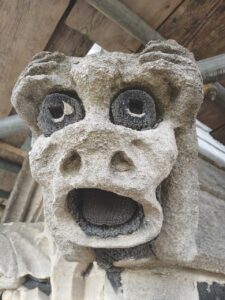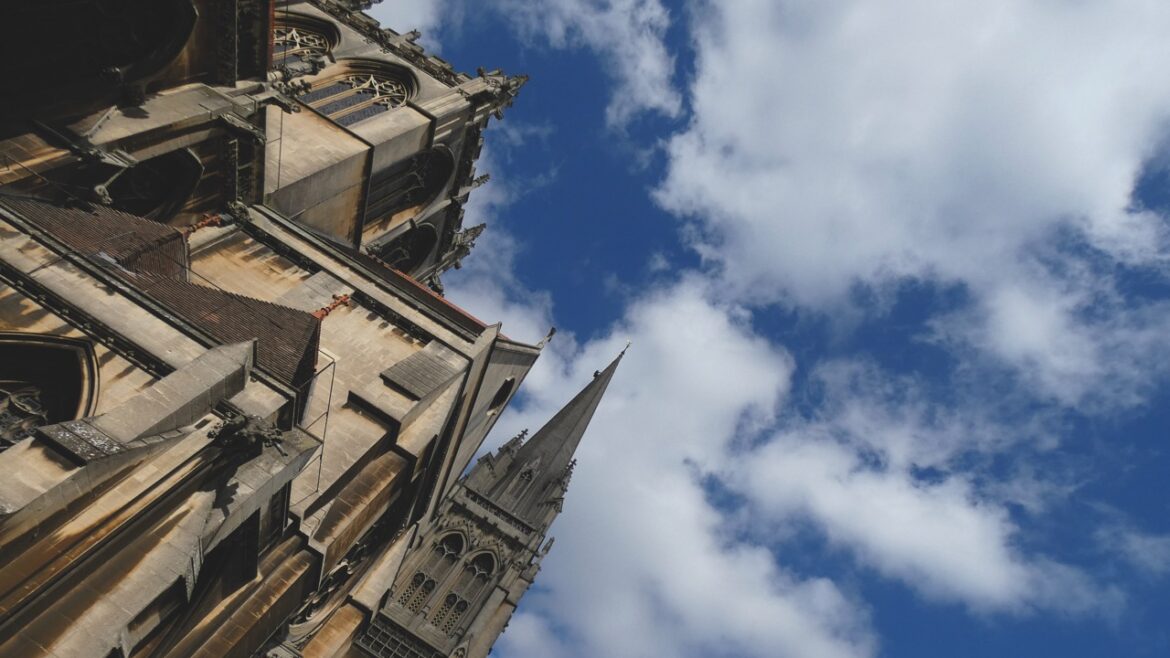Granted exclusive access behind the scenes at the ambitious conservation project currently underway at the Church of Our Lady of the Assumption and the English Martyrs near Parker’s Piece, Louise Hoffman dons her hard hat and high vis
You might have wondered what’s going on at the iconic 214ft steeple of the Church of Our Lady of the Assumption and the English Martyrs – that towering Victorian Gothic marvel that sits at a crossroads of Cambridge’s main artery, Hills Road. Clad in a fetching robe of yellow and green mesh for the past few months, an impressive 19 levels of scaffolding are erected beneath, providing access to every piece of architectural and decorative exterior stonemasonry from ground to spire.
As anyone who has even briefly gazed up at this ostentatious building will confirm, there’s no shortage of awe-inspiring ornamentation, from gargoyles and grotesques to statues and tracery. Get up close, however, and you’ll very quickly discover that all the decorative stonework is long past its prime.
In July 2023, fears of falling masonry led to the main road being closed off to protect pedestrians, cyclists and motorists, triggering a major structural investigation and, now, a full restoration project. But what exactly does the work entail?
Invited to climb up the scaffolding and see for myself, I embarked on a fascinating tour all the way to the top of this Grade I listed building with Matthew Champion, historic churches support officer for the Roman Catholic Diocese of East Anglia.
Where it all began

The project has brought together surveyors, stonemasons and engineers
In keeping with its design, even the backstory of the Church of Our Lady of the Assumption and the English Martyrs feels like an elaborate one.
It was built in 1887-90 under the supervision of Canon Christopher Scott – at the sole expense of Yolande Lyne-Stephens (née Duvernay), a renowned French dancer who had performed in Paris and London, and was the widow of wealthy Cambridge banker and MP Stephens Lyne-Stephens, who was said to have become the richest commoner in England when he inherited his family fortune in 1851.
Yolande was a great supporter of the Catholic cause and spared no expense in funding the design, construction and furnishing of both church and presbytery, offering up £70,000 for the project – that’s equivalent to around £10 million today!
A limited competition, open to Catholic architects, was held to choose a design for the new church. Dunn, Hansom & Dunn of Newcastle were selected with an original design described as Early English, but which soon evolved into a more extravagant Decorated Gothic style.
Up close and personal
The imposing design and intricate stonework are jaw-droppingly impressive, especially when you are face-to-face with the various beasties that protrude from the steeple sides. But, as Matthew explains as he leads me up the metal staircase from one scaffolding level to the next, one or two Victorian architectural decisions have proved less than ideal in the long term.
Firstly, there’s the choice of stone. Everything that lies above the base course of Casterton stone and plinth of Ancaster stone is made of Bath stone from Combe Down – a beautiful material, but sadly much inclined to erosion. Soft and porous, it’s easy to carve, but when subjected to the elements, including acid rain and both modern and historic air pollution (such as that of the Industrial Revolution, during which time the church was built), it can erode, crumble and discolour.
It also forms thick, black crusts that struck me as resembling a sort of anti-lichen, building up in the eyes and mouths of the face-pulling grotesques and enhancing their menacing intent. It’s this layer of pollution that is also responsible for giving the church its nickname – the black church.
Many of the intricately carved creatures, mostly by Ovens of Preston, and heavenly cast of saints and angels, by Boulton of Cheltenham, are strengthened with internal iron rods. In theory, this is sensible, but in practice – as time goes on and water seeps inside, freezes and thaws – the stone around these rods can quite literally explode. This is evident in various places up the tower, where metal protrudes from severed stonework.
It was these kinds of issues that the first-response conservation specialists Universal Stone Ltd highlighted in 2023 after exploring the exterior of the building on a colossal cherry picker. Emergency works were swiftly launched by the Diocese to have any dangerous stonework removed and to formulate a long-term plan for repair and restoration, in collaboration with the parish, church architect Henry Freeland and Historic England.

The works are seeking to assess, clean and repair intricate detailing on the facade
What you see now is that particular restoration project underway, and Matthew is part of the team delivering it – one that involves an array of specialist contractors and surveyors, skilled stonemasons and even the Department of Engineering at the University of Cambridge, which undertook research led by MEng student Rajiv Nailadi to measure vibrations and movement in the pinnacles of the tower using a laser.
It’s an ambitious plan that spans processes of assessment, cleaning and essential repair, including the restoration of multiple pinnacles, replacement of severely degraded stonework and the reinforcement of at-risk masonry.
Funded by the parish, The Albert Gubay Charitable Foundation, Historic England and a number of smaller grants, the project began at the tower having been identified as most urgently in need of repair, but it will subsequently move on to other parts of the building, including a leaky south aisle and the richly decorated polygonal apse. The first stage alone will cost in the region of £1 million.
But, as rector and parish priest Rt Revd Mgr Canon Eugène Harkness affirms, it’s worth every penny: “It’s one of the largest Roman Catholic churches in the country; the significant size, landmark features and stunning architectural detail were intended to suit its anticipated role as the centre of Catholic life at Cambridge University. We want to keep our beautiful church as a living and dynamic vehicle of praise to God in the centre of this wonderful city.”
How long will it take? Well, Matthew is realistic about the amount of work involved, both in the current multi-stage project and the regular assessments that will be required on a two- or three-yearly basis going forward. Likening it to a bit of a ‘Forth Bridge situation’, he admits that – with work on the tower alone likely to take up the rest of this year – once completed, the team might find themselves needing to start from the beginning all over again!
Watch this space for updates on the project, and you can find out more about the church and its fundraising efforts at olem.org.uk

